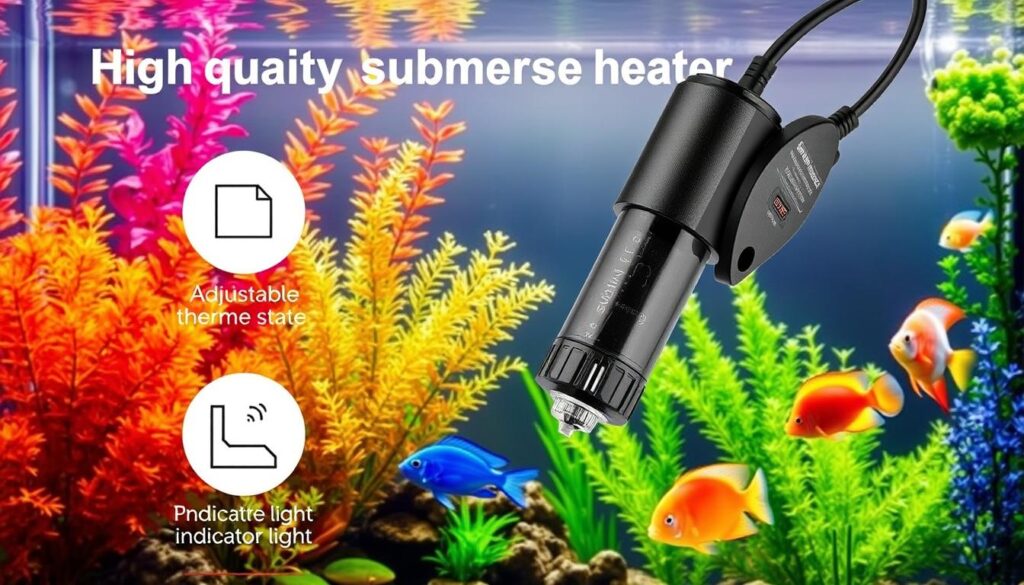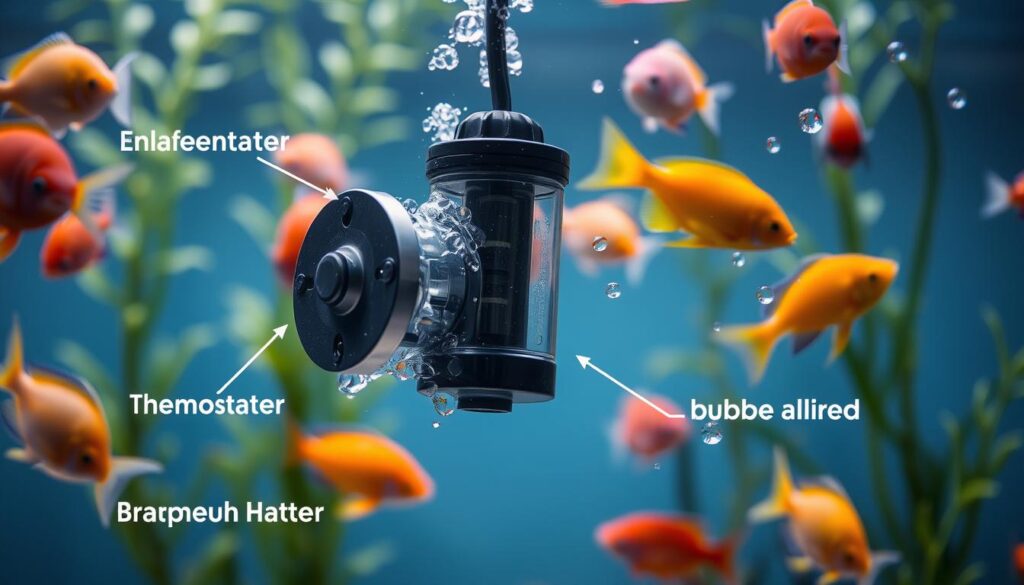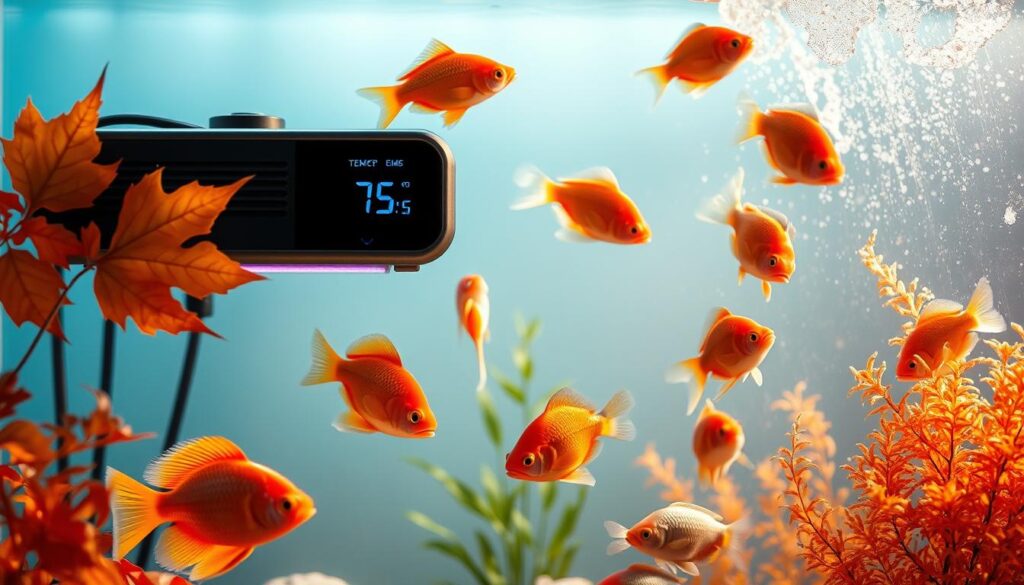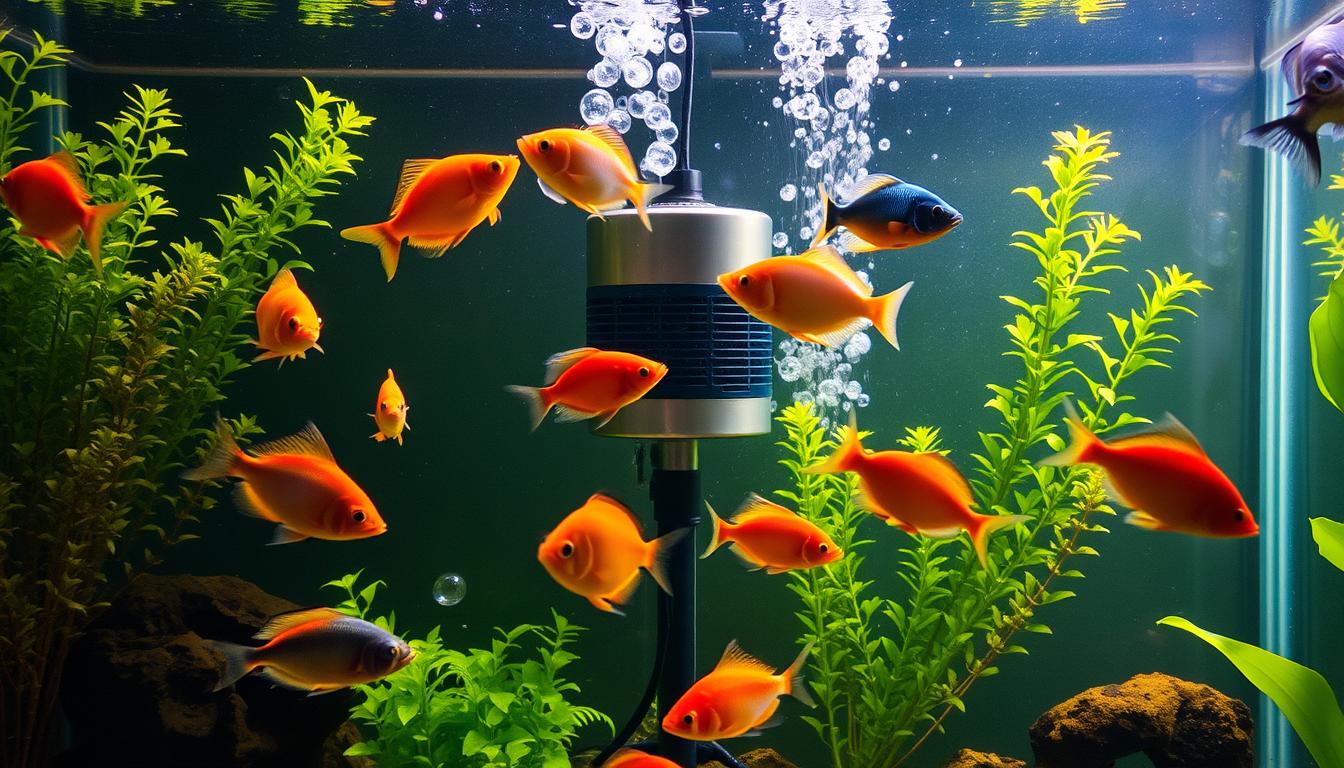Keeping your aquarium water at a stable temperature is key for your fish’s health. An aquarium heater guide can help you pick the perfect heater for your tank. This guide will share important tips and factors to think about when choosing and using an aquarium heater.
An aquarium heater is a must-have for any aquarium. It keeps the water temperature stable, which is vital for your fish’s health. Without a heater, your fish might get stressed and their immune system could weaken. In this article, we’ll give you a detailed guide on using and maintaining aquarium heaters.
Our buying guide will walk you through the different heaters available. You’ll learn about their features and benefits. By the end of this article, you’ll know how to pick the best heater for your tank and use it right.
Key Takeaways
- Maintaining a stable water temperature is crucial for the health and well-being of your fish.
- An aquarium heater is a vital component of any aquarium setup.
- This aquarium heater guide will provide you with essential tips and factors to consider when selecting and using an aquarium heater.
- Our aquarium heater buying guide will help you navigate the different types of heaters available.
- Choosing the right heater for your tank is essential for the health and well-being of your fish.
- Proper use and maintenance of an aquarium heater can help prevent stress and disease in your fish.
- This comprehensive aquarium heater guide will cover all aspects of heater use and maintenance.
Understanding Why Your Aquarium Needs a Heater
Keeping the water temperature stable is key for your fish’s health. Changes in temperature can stress them out, leading to sickness. When picking the best aquarium heater, think about what your fish need.
Studies show that temperature changes harm fish health. To keep your tank healthy, you must pick the right heater. Consider your tank’s size, the fish you have, and the temperature you want.
The Impact of Temperature on Fish Health
Temperature affects how fish grow, their immune system, and their metabolism. Each fish type needs a certain temperature. The right heater helps keep your fish happy and healthy.
Natural Temperature Fluctuations in Home Aquariums
Home aquariums can face temperature changes due to room temperature, lighting, and equipment. To keep the temperature steady, choose a heater that can handle these changes.
Species-Specific Temperature Requirements
When picking a heater, think about your fish’s temperature needs. Tropical fish need warmer water, while goldfish prefer cooler. Knowing your fish’s needs helps you pick the best aquarium heater for a healthy home.
Different Types of Aquarium Heaters Available Today
Choosing an aquarium heater can be tricky. There are many types, each with its own pros and cons. Submersible heaters are popular for their simplicity and energy savings.
Other options include hang-on-back heaters and external heaters. They offer benefits like easy setup and upkeep. It’s key to match your aquarium’s needs with the right heater type.
When picking a heater, think about your tank size, fish type, and budget. Researching and comparing heaters helps you choose wisely. Aquarium heater reviews can also offer helpful insights.
Essential Features of Quality Aquarium Heaters
Choosing the right aquarium heater is key for your fish’s health. Top aquarium heater reviews stress the need for good temperature control and safety shut-offs. These features prevent accidents and keep water temperature stable, crucial for fish health.
Temperature Control Mechanisms
A quality aquarium heater must have a dependable temperature control. This lets you set and keep a specific temperature, vital for fish health. Look for heaters with digital controls and a broad temperature range for the best setting.

Safety Shut-off Systems
Safety shut-offs are a must in aquarium heaters. They turn off the heater if it malfunctions or if water temperature gets too high. This safety feature prevents accidents and keeps your fish safe. By following aquarium heater safety tips, you can avoid risks and keep your aquarium healthy.
- Look for heaters with automatic shut-off systems
- Check the heater’s temperature range and accuracy
- Read reviews and follow top aquarium heater reviews to find the best heater for your aquarium
Calculating the Right Heater Wattage for Your Tank
When setting up aquarium heater, finding the right wattage is key. The wattage needed depends on the tank size, fish type, and desired temperature. An aquarium heater wattage calculator can help figure this out.
A common guideline is 2-5 watts per gallon of water. But, this can change based on your fish’s needs and the temperature you aim for. For instance, a 20-gallon tank at 78°F might need a 40-100 watt heater.
An aquarium heater wattage calculator can give you the exact wattage needed. It considers your tank size, fish type, and desired temperature. This ensures your heater is just right for your fish and keeps the tank healthy.
When figuring out the heater wattage, remember a few things:
- Tank size and volume
- Type of fish and their temperature needs
- Desired temperature and how it changes
Think about these points and use an aquarium heater wattage calculator. This way, your heater will be the right size and keep your fish happy and healthy.
Complete Aquarium Heater Guide for Beginners
Starting an aquarium can feel overwhelming, especially for newbies. The heater is key to keeping the water at a good temperature for your fish. This guide will help beginners set up and care for their aquarium heaters.
First, you need to pick the right heater for your tank. Think about your tank’s size, the fish you have, and the temperature you want. A good guide will give you the info you need to make the right choice.
Initial Setup Instructions
Here’s how to set up your heater:
- Put the heater in the tank, away from decorations or plants.
- Set the temperature to 72-82°F (22-28°C).
- Keep an eye on the temperature to make sure it stays steady.
Temperature Adjustment Guidelines
After setting up, adjust the temperature for your fish. Raise it by 1-2°F (0.5-1°C) every 30 minutes until you hit your target.
Common Beginner Mistakes to Avoid
Beginners often make these mistakes:
- Not watching the temperature closely enough.
- Not changing the temperature for your fish’s needs.
- Not keeping a stable temperature range.
By following this aquarium heater guide and avoiding these errors, you can create a great home for your fish. Always do your research and understand what your fish and tank need for the best care.
Optimal Heater Placement in Different Tank Setups
When it comes to aquarium heater placement, the type of tank and the location of the fish are crucial. The goal is to avoid hot spots and ensure even heat distribution. Proper aquarium heater installation is key to a stable and healthy environment for the fish.
Some tips to keep in mind for optimal heater placement include:
- Placing the heater near the filter outlet to distribute the heat evenly
- Avoiding placement near plants or decorations that can block the heat
- Keeping the heater at least 2-3 inches away from the glass walls of the tank
By following these guidelines and considering your tank’s specific needs, you can ensure your aquarium heater is installed and placed correctly. This will provide a healthy and thriving environment for your fish.
Maintaining Stable Water Temperature
Keeping the water temperature stable is key for fish health in an aquarium. Aquarium heater maintenance is vital to ensure the heater works right. Regular checks and upkeep stop sudden water temperature changes, which harm fish.
To keep the water temperature stable, several methods work well. These include:
- Using multiple heaters to spread heat evenly in the tank
- Implementing aquarium temperature control systems to watch and adjust the temperature as needed
- Dealing with room temperature changes by insulating the tank or using a thermometer to check the temperature
By using these methods and doing regular aquarium heater maintenance, owners can make a stable and healthy space for their fish. This helps prevent stress and disease, leading to a thriving aquarium ecosystem.
Signs Your Aquarium Heater Needs Replacement
Keeping your aquarium heater in good shape is key. Over time, it may show signs of wear. This means it’s time for aquarium heater replacement. A big sign is when it stops working right, not keeping the water at a steady temperature.
Other signs include corrosion and wear on the heater. Corrosion can cause leaks, harming your aquarium and fish. Check for damage like cracks or rust. Also, make sure the temperature is right. If you see these signs, it’s time to think about aquarium heater troubleshooting or getting a new one.
Some common problems that might need aquarium heater replacement or fixing include:
- Temperature changes
- Heater not turning on or off
- Leaks or corrosion
Spotting these signs early and acting fast keeps your fish safe and healthy. Regular checks can catch issues before they get worse. This makes aquarium heater replacement or aquarium heater troubleshooting easier.
Troubleshooting Common Heater Problems
A working heater is key to a healthy aquarium. But, heaters can fail, leading to temperature issues that harm fish. Knowing how to fix these problems is crucial.
Common issues include wild temperature swings and heaters not working right. If this happens, you must act fast to protect your fish. Check the heater’s settings, make sure it’s installed right, and clean it if needed.
Identifying the Problem
To fix heater troubles, find the main cause. Watch the water temperature, check the power cord, and ensure the heater fits well in the tank. If unsure, look at the manual or get help from a pro.

Emergency Temperature Management
Have a plan for when the heater breaks down. Use a spare heater or insulate the tank to avoid big temperature changes. Knowing how to repair your heater keeps your fish safe and healthy.
By following these steps and staying alert, you can avoid heater problems. Regular care and troubleshooting keep your aquarium a great place for your fish.
Advanced Temperature Control Techniques
For the best aquarium temperature management, you need advanced techniques. These include using temperature controllers, thermometers, and heat pumps. They help keep the water at a steady temperature. This makes a healthy home for fish and other sea creatures.
Some important advanced techniques are:
- Using temperature controllers to regulate the heater and prevent overheating
- Installing thermometers to monitor the water temperature accurately
- Utilizing heat pumps to maintain a consistent temperature, especially in larger tanks
By using these advanced aquarium heater control methods, you can keep your tank stable and healthy. This is good for your fish’s well-being and helps them live longer.
Safety Measures When Using Aquarium Heaters
Aquarium heater safety is key to avoid accidents and keep your fish healthy. It’s important to follow safety steps when using aquarium heaters. This means being careful with electrical safety and keeping the heater away from flammable things.
Regular maintenance is also crucial to avoid accidents. Check the heater’s temperature settings and make sure water is flowing well. Also, watch how the heater is working. By doing these things, you can keep your fish safe and healthy.
Electrical Safety Considerations
- Keep the heater away from flammable materials
- Avoid overloading the electrical circuit
- Use a grounded outlet to prevent electrical shock
Prevention of Heater Accidents
To stop heater accidents, follow the maker’s instructions and don’t skip maintenance. Check the heater’s temperature, make sure water is moving, and watch how it’s working. Being careful and proactive helps keep your fish safe and healthy.
Seasonal Adjustments for Aquarium Heating
As the seasons change, it’s key to adjust your seasonal aquarium heater settings. This keeps the water temperature stable. Changes in room temperature can harm your fish. Making these changes helps keep your fish healthy.
To adjust your aquarium temperature, start by watching the tank’s temperature. Then, adjust the heater as needed. You might also need extra heating or cooling to keep the right temperature. Here are some tips to help:
- Check the tank’s temperature often to spot any changes.
- Change the heater’s setting to keep the best temperature for your fish.
- Use a thermometer to get an accurate water temperature reading.
By following these tips and making the right seasonal aquarium heater adjustments, you can create a great home for your fish. Always put your fish’s health first by keeping the water temperature stable and optimal.

Understanding Heater Warranties and Maintenance
Knowing about aquarium heater warranties and maintenance is key. It helps keep your heater working well for a long time. Regular care can stop problems before they start.
Keeping your heater in check means checking its settings, cleaning it, and fixing any broken parts. Also, understanding your warranty is important. It can help if your heater breaks down.
Warranty Coverage Types
There are many types of warranties for aquarium heaters. You can get limited warranties or extended ones. Limited warranties last for a set time, while extended ones last longer.
Regular Maintenance Schedule
It’s vital to keep up with regular maintenance. This includes daily, weekly, and monthly checks. It makes sure your heater is always working right.
Professional Services vs DIY
Some maintenance tasks you can do yourself, but others need a pro. Knowing when to call for help is important. It keeps your heater and aquarium safe.
Understanding your heater’s warranty and maintenance is crucial. It keeps your heater running smoothly and your fish healthy. Regular care and knowing your warranty options give you peace of mind.
Special Considerations for Different Tank Types
Choosing the right aquarium heater for different tank types is important. Each tank type, like freshwater, saltwater, and planted tanks, has its own needs. These needs help keep fish and other aquatic life healthy.
Freshwater tanks need a heater to keep the water between 72-82°F (22-28°C). Saltwater tanks require a heater for a temperature of 72-78°F (22-25°C). Planted tanks need a heater to keep the water between 75-85°F (24-29°C). Aquarium heater compatibility is also key. Some heaters don’t work well with certain tanks or sizes.
- Tank size and type
- Desired temperature range
- Aquarium heater compatibility
- Energy efficiency and safety features
By thinking about these points and picking the right heater, you can keep your fish and other aquatic life healthy.
Remember, a good aquarium heater is crucial. The right one can greatly improve your fish’s health and happiness.
Master Your Aquarium’s Temperature Management
To manage your aquarium’s temperature well, choose the right heater. It should fit your tank size and meet your fish’s needs. Installing and keeping the heater in good shape is key for stable water temperatures.
Use a good thermometer to check the temperature often. Adjust it as needed to keep your fish happy and healthy.
Knowing how to fix common heater problems is important. Issues like uneven temperatures or breakdowns can upset your fish’s home. By solving these problems fast, you keep your aquarium healthy and balanced. Learning to manage temperature will help you create a great home for your fish.
FAQ
What are the different types of aquarium heaters available?
There are three main types of aquarium heaters. These include submersible heaters, hang-on-back heaters, and external heaters. Each type has its own benefits and drawbacks, like ease of use and energy efficiency.
How do I calculate the right heater wattage for my tank?
To find the right heater wattage, consider your tank’s size, the fish type, and the desired temperature. An aquarium heater wattage calculator can help you figure out the correct wattage for your setup.
What are the essential features of a quality aquarium heater?
A good aquarium heater should have a few key features. These include temperature control, a safety shut-off, and durable materials. These features help keep your fish safe and healthy.
How do I properly set up and maintain my aquarium heater?
Setting up your heater involves following a step-by-step guide. This includes initial setup and adjusting the temperature. Regular maintenance and monitoring are also crucial to ensure the heater works well.
What are the signs that my aquarium heater needs to be replaced?
If your heater malfunctions, corrodes, or shows wear and tear, it’s time for a new one. Regular checks and timely replacements are key to keeping your fish safe.
How can I troubleshoot common aquarium heater problems?
Troubleshooting heater issues starts with identifying the problem. This could be temperature issues or the heater not working. Corrective actions, like adjusting the temperature or replacing the heater, can solve these problems.
What safety measures should I take when using an aquarium heater?
Safety is crucial when using an aquarium heater. This includes electrical safety and preventing accidents. Always prioritize the safety of your fish and yourself.
How do I make seasonal adjustments to my aquarium heater?
Seasonal changes may require adjustments to your heater’s temperature. This could mean changing the heater’s setting or using additional devices to keep the water at a stable temperature.
What special considerations are there for different tank types when using an aquarium heater?
Different tanks, like freshwater, saltwater, or planted tanks, have unique needs. It’s important to choose the right heater for your tank type and use it correctly.

